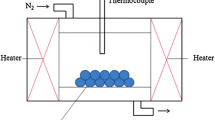Abstract
The re-dissolution of unstable iron oxides during the low-temperature hematite process significantly increases the iron ions concentration in solution after iron removal in zinc hydrometallurgy. The reason for the re-dissolution of precipitated hematite was determined through simulated iron removal experiments in an autoclave. It was caused by e.g., weak acid solubility resistance in high acidity and the poor crystallinity of hematite. In order to solve the problem of re-dissolution of hematite precipitated in a short time, three improving methods, namely increasing the reaction temperature, extending the reaction time in the autoclave, and reducing the acidity of hematite process, have been systematically studied. Increasing the reaction temperature is not economical from the perspective of industrial production, and extending the reaction time does not meet the original intention of the zinc smelter to increase production capacity. Although zinc sulfide concentrate as a neutralizing agent can increase the pH of the slurry, the hematite produced does not have the potential for sales. When 12 g/L zinc calcine was added, the residual Fe concentration in solution after iron removal within 90 min can be controlled below 1 g/L, and high-grade hematite with Fe, Zn, and S contents of 56.62%, 2.09%, and 2.78% can be produced.






Similar content being viewed by others
References
C. Li, Z. Deng, C. Wei, G. Fan, X. Li, M. Li, and Y. Wang, Hydrometallurgy 178, 294 (2018).
C. Li, C. Wei, S. Yi, G. Fan, Z. Deng, X. Li, and M. Li, Hydrometallurgy 189, 105112 (2019).
A. Pappu, M. Saxena, and S.R. Asolekar, Sci. Total. Environ. 359, 232 (2006).
X. Peng, X. Li, C. Wei, Z. Deng, M. Li, and B. Yang, Miner. Eng. 186, 107769 (2022).
A. Asimi, K. Gharibi, E. Abkhoshk, F. Moosakazemi, and S.C. Chelgani, Materials 13, 4662 (2020).
T. Nan, J. Yang, C. Tang, W. Zeng, Q. Zhu, S. Tang, and C. Fu, Hydrometallurgy 203, 105624 (2021).
T. Nan, J. Yang, K. Hu, W. Long, S. Tang, Q. Zhu, J. Liu, C. Tang, and W. Zeng, J. Clean. Prod. 378, 134382 (2022).
J.E. Dutrizac and A. Sunyer, Can. Metall. Q. 51, 11 (2012).
P. Asokan, M. Saxena, and S.R. Asolekar, Mater Charact 61, 1342 (2010).
A. Ali and R.A. Khan, Mater. Today Proc. 93, 302 (2023).
P. Mehra, R.C. Gupta, and B.S. Thomas, J. Clean. Prod. 119, 59 (2016).
T.C. Cheng and G.P. Demopoulos, Ind. Eng. Chem. Res. 43, 6299 (2004).
Y. Xing, H. Liu, Z. Deng, C. Wei, X. Li, M. Li, and Y. Yang, Hydrometallurgy 200, 105561 (2021).
Z. Deng, F. Yang, C. Wei, B. Zhu, P. Zeng, X. Li, C. Li, and M. Li, Trans. Nonferrous Met. Soc. China 30, 492 (2020).
T.C. Cheng, G.P. Demopoulos, Y. Shibachi, and H. Masuda, Electrometallurgy and Environmental Hydrometallurgy (John Wiley & Sons Ltd, 2003), pp1657–1674.
J. Lu and D. Dreisinger, Hydrometallurgy 140, 59 (2013).
J. Li, C. Shi, W. Zeng, Y. Wang, Z. Hong, Y. Ma, and L. Fang, J. Environ. Sci. 113, 260 (2022).
G. Ceriotti, and A. Guadagnini, Challenges and Innovations, in Geomechanics. ed. by M. Barla, A. Di Donna, and D. Sterpi (Springer International Publishing, Cham, 2021), pp. 829–836.
G.J. Smith, R.W. McDowell, L.M. Condron, K. Daly, D. Ó hUallacháin, and O. Fenton, J. Environ. Qual. 50, 1207 (2021).
M. Aeppli, S. Vranic, R. Kaegi, R. Kretzschmar, A.R. Brown, A. Voegelin, T.B. Hofstetter, and M. Sander, Environ. Sci. Technol. 53, 8736 (2019).
F. Elgersma, G.J. Witkamp, and G.M. Van Rosmalen, Hydrometallurgy 34, 23 (1993).
V. Umetsu, K. Tozawa, and K. Sasaki, Can. Metall. Q. 16, 111 (1977).
T.C. Cheng, Production of Hematite in Acidic Zinc Sulphate Media (Materials Engineering McGill University, 2002), pp1–10.
T. Yamada, S. Kuramochi, S. Sato, and Y. Shibachi, The recent operation of the hematite process at the Iijima Zinc Refinery, in International Symposium on Zinc and Lead Processing (1998).
H. Arima, T. Aichi, and Y. Kudo, Recent improvement in the hematite precipiation process at the Akita Zinc Company, in Iron Control Technologies Proceedings of the Third International Symposium on Iron Control in Hydrometallurgy (2004).
M. Eguchi and A. Yazawa, J. Min. Metallur. Inst. Jpn. 87, 329 (1971).
M.C. Ruiz, J. Zapata, and R. Padilla, Hydrometallurgy 89, 32 (2007).
Acknowledgements
This research was financially supported by the National Natural Science Foundation of China (Grant Nos. 51964029), Applied Basic Research Project of Yunnan Province of China (Grant Nos. 202202AG050025), and Yunnan Major Scientific and Technological Projects (Grant Nos. 202302AG050008), for which the authors are sincerely grateful, and we gratefully acknowledge many helpful comments and suggestions from anonymous reviews.
Author information
Authors and Affiliations
Corresponding author
Ethics declarations
Conflict of interest
The authors declare that they have no known competing financial interests or personal relationships that could have appeared to influence the work reported in this paper.
Additional information
Publisher's Note
Springer Nature remains neutral with regard to jurisdictional claims in published maps and institutional affiliations.
Rights and permissions
Springer Nature or its licensor (e.g. a society or other partner) holds exclusive rights to this article under a publishing agreement with the author(s) or other rightsholder(s); author self-archiving of the accepted manuscript version of this article is solely governed by the terms of such publishing agreement and applicable law.
About this article
Cite this article
Yang, B., Lu, Z., Li, X. et al. The Prevention of Re-dissolution of Unstable Iron Oxides During the Low-Temperature Hematite Process. JOM (2024). https://doi.org/10.1007/s11837-024-06612-4
Received:
Accepted:
Published:
DOI: https://doi.org/10.1007/s11837-024-06612-4




